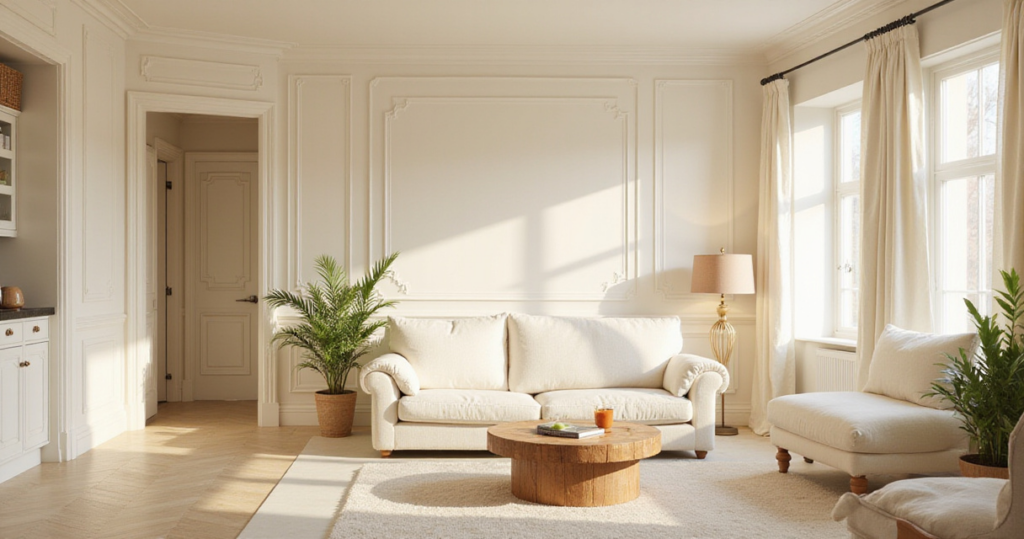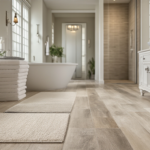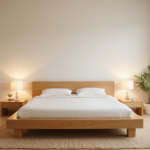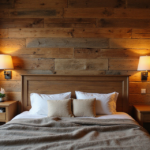Creating a sophisticated cream living room requires more than just choosing light colors—it demands strategic layering, thoughtful contrast, and industrial-inspired elements that prevent the space from feeling flat. As someone who’s transformed countless urban lofts and modern homes, I’ve learned that cream serves as the perfect foundation for bold architectural details and refined metallic accents. The key lies in building depth through varied textures, strategic lighting, and carefully curated materials that create visual weight without overwhelming the serene palette.
These 23 brilliant ideas will guide you through creating a cream living room that balances softness with structure, warmth with sophistication. From selecting performance fabrics that withstand city living to incorporating industrial elements that add edge, each strategy builds upon the next to create a space that’s both livable and luxurious. Whether you’re working with a converted warehouse space or a traditional home, these techniques will help you achieve the perfect balance of comfort and contemporary style.
1. Choose Performance Fabrics for Urban Durability
When designing a cream living room for modern city life, selecting high-performance fabrics isn’t just practical—it’s essential for maintaining that crisp, architectural aesthetic. I always specify fabrics with Crypton or similar treatments for cream upholstery, as these advanced textiles repel stains while maintaining the luxurious hand-feel that elevates the space. The key is finding performance fabrics that don’t sacrifice texture; look for solution-dyed options that offer the depth and visual interest necessary to prevent your cream palette from appearing sterile.
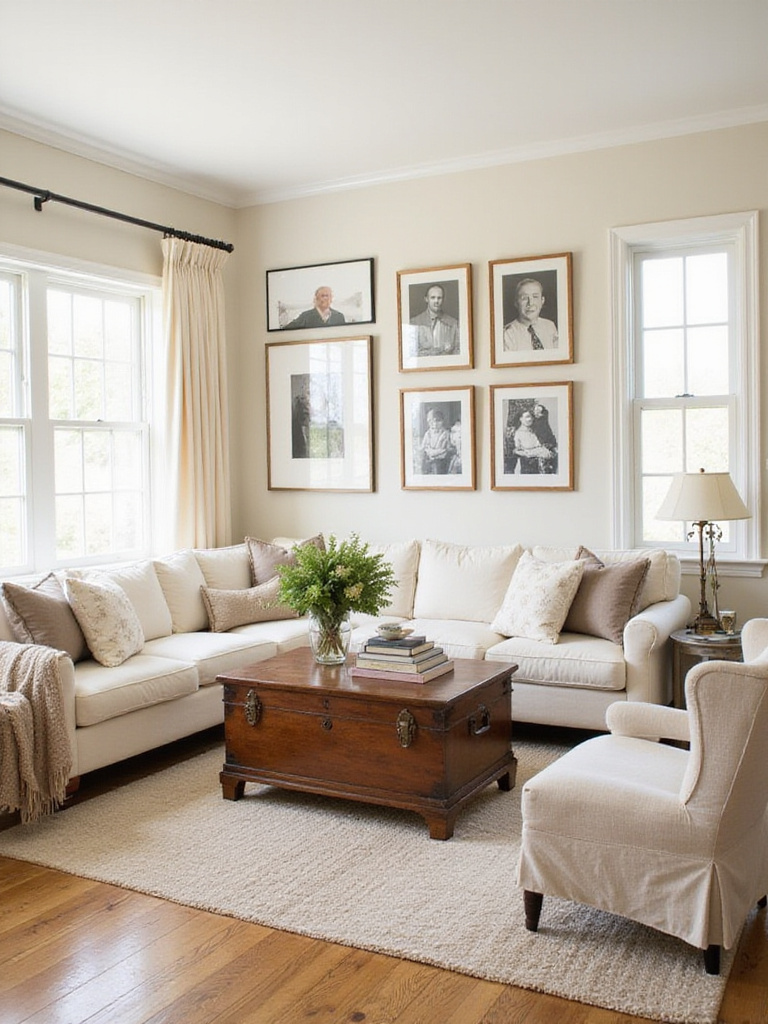
Consider the structural qualities of your fabric choices alongside their protective properties. Tightly woven performance velvets provide both durability and the kind of rich texture that plays beautifully against industrial elements like exposed brick or steel accents. For families or frequent entertainers, I recommend fabrics with Wyzenbeek ratings above 25,000 double rubs—this commercial-grade durability ensures your cream seating maintains its pristine appearance even with heavy use. The investment in quality performance fabrics pays dividends in both longevity and peace of mind, allowing you to fully enjoy your space without constant worry about maintenance.
What makes this design special is the way performance technology has evolved to enhance rather than compromise aesthetic appeal, opening up new possibilities for sophisticated cream palettes.
2. Layer Industrial Metals for Architectural Interest
Strategic placement of varied metal finishes transforms a cream living room from soft and safe to sophisticated and dynamic. I prefer combining warm brass or copper elements with cooler steel or iron accents to create the kind of layered complexity that defines truly exceptional interiors. The contrast between cream’s softness and metal’s inherent strength creates visual tension that keeps the eye engaged while maintaining the room’s serene foundation.
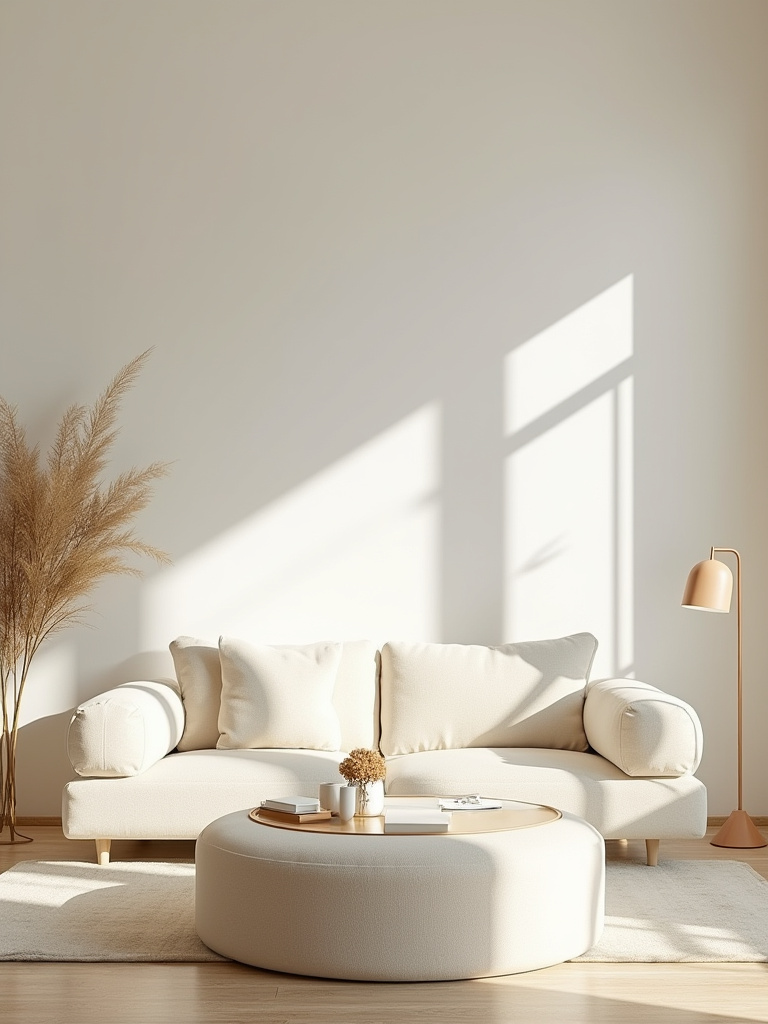
Focus on architectural applications where metals can serve both functional and aesthetic purposes. A steel-framed coffee table with a limestone top, brass floor lamps with adjustable arms, and brushed nickel hardware on built-ins create a cohesive metallic narrative without overwhelming the space. The key is varying the scale and finish of your metal elements—mix polished surfaces that reflect light with matte finishes that absorb it, creating depth through the interplay of reflection and shadow. This approach prevents the metals from competing while ensuring each element contributes to the overall architectural story.
The designer’s secret here is to treat metals as structural elements rather than mere decoration, building a framework that supports the cream palette.
3. Incorporate Concrete Accents for Modern Edge
Concrete elements bring an unmistakable urban sophistication to cream living spaces, providing the kind of raw texture that prevents neutral palettes from feeling too precious. I often specify polished concrete side tables or fireplace surrounds that offer smooth, cool surfaces contrasting beautifully with warm cream textiles. The natural variations in concrete—subtle color shifts, micro-textures, and organic imperfections—add visual interest that manufactured materials simply cannot replicate.
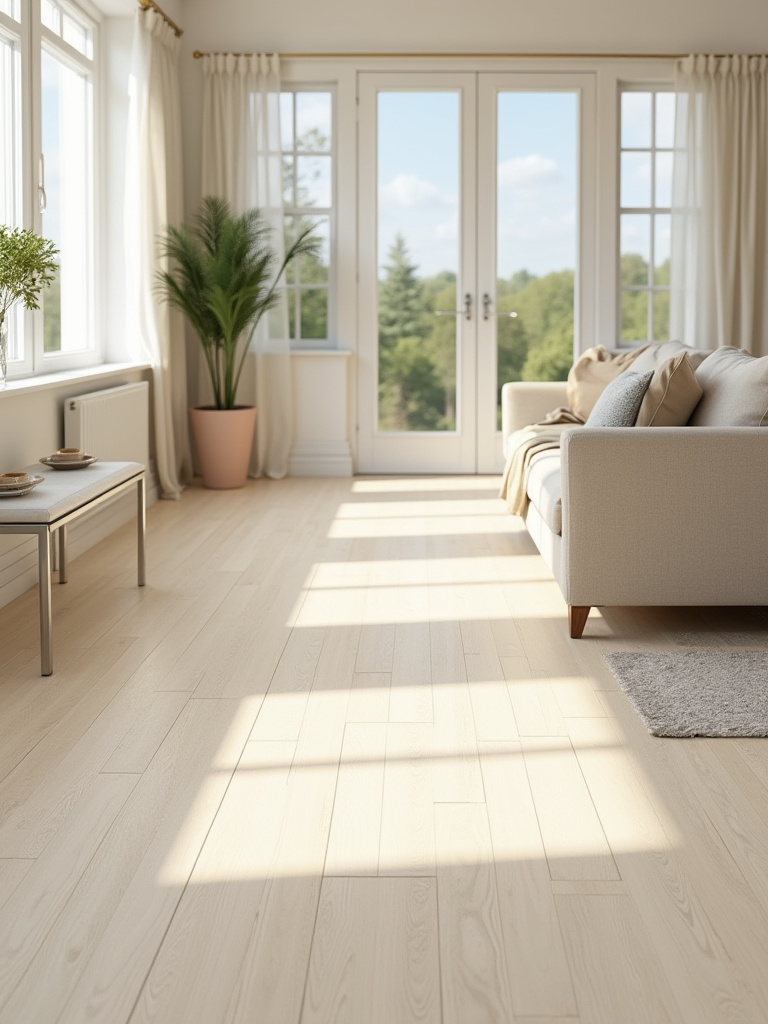
The beauty of concrete lies in its versatility and the way it ages gracefully, developing a patina that enhances rather than detracts from its appearance. Consider concrete planters for oversized greenery, pendant light fixtures with concrete shades, or even polished concrete flooring in open-plan spaces. When working with concrete in cream rooms, I prefer lighter gray tones that complement rather than compete with the soft palette, creating harmony while maintaining the material’s inherent strength and character.
Unlike conventional options, this approach reduces the risk of your cream space feeling overly feminine or traditional, instead anchoring it firmly in contemporary design.
4. Design Zones with Architectural Lighting
Layered lighting in a cream living room should function like architecture itself—defining spaces, creating hierarchy, and establishing mood through carefully planned illumination. I design lighting schemes that include statement fixtures with strong geometric forms alongside subtle accent lighting that highlights texture and architectural details. Track lighting with adjustable spots allows you to highlight specific elements like artwork or textured walls, while pendant lights with industrial-inspired designs serve as sculptural focal points.

The technical aspect of lighting cream spaces requires understanding how different light temperatures affect neutral tones. I specify 2700K LED bulbs for ambient lighting to enhance cream’s warmth, while using 3000K for task lighting to maintain clarity without creating harsh contrasts. Dimmer controls on every circuit allow for dynamic adjustment throughout the day, transforming the space from bright and energizing during daylight hours to warm and intimate for evening relaxation. Consider linear LED strips hidden behind floating shelves or under-cabinet lighting that creates dramatic shadow play against cream walls.
The unexpected pairing that always works is combining industrial-style fixtures with cream’s softness—the contrast creates sophisticated tension.
5. Select Statement Rugs That Ground the Space
A well-chosen rug serves as the foundation for your entire cream living room design, providing both visual weight and textural interest that prevents the space from feeling insubstantial. I prefer large-scale rugs that extend beyond the furniture footprint, creating a defined zone while allowing the cream palette to breathe. Natural fiber rugs like jute or sisal offer the kind of organic texture that complements industrial elements, while geometric patterns in muted tones add contemporary sophistication without overwhelming the serene base.
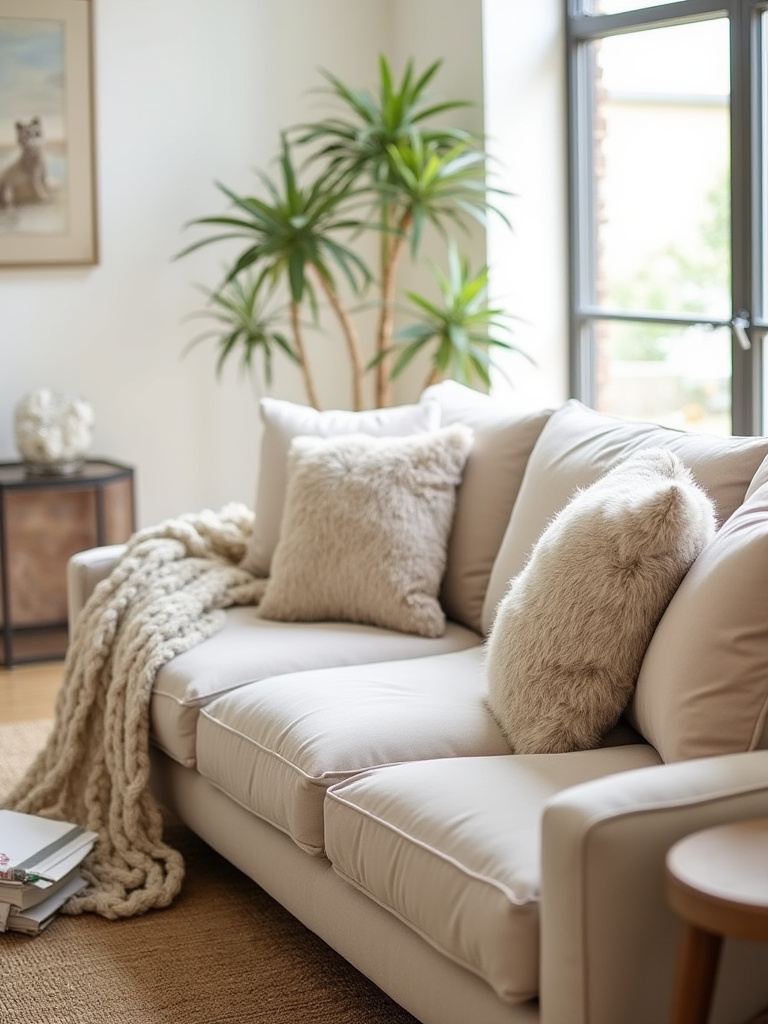
The scale and placement of your rug dramatically affects the room’s proportions and flow. In open-plan spaces, I use rugs to define distinct areas within the larger volume, creating intimate conversation zones that feel purposeful rather than arbitrary. Consider layering techniques—a large neutral rug topped with a smaller patterned piece—to add depth and visual interest. The key is selecting rugs with enough visual weight to anchor your furniture arrangement while maintaining the clean, uncluttered aesthetic that makes cream palettes so appealing.
The composition comes together when you consider the rug as architecture for the floor, defining circulation patterns and spatial relationships.
6. Build Texture Through Natural Materials
Incorporating raw, natural materials prevents cream living spaces from feeling sterile while adding the kind of authentic texture that can’t be manufactured. I frequently specify live-edge wood elements, natural stone accents, and unfinished metals that bring organic irregularity to otherwise refined spaces. These materials provide essential contrast to cream’s uniformity while maintaining the sophisticated aesthetic that defines contemporary design.
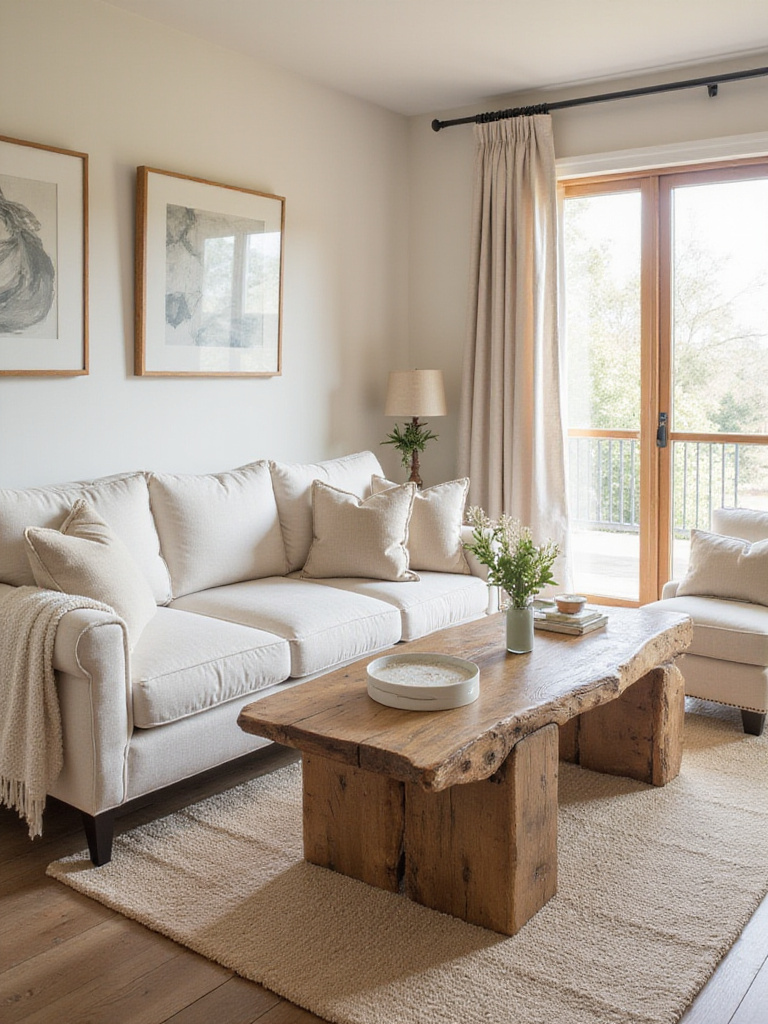
The strategic placement of natural materials creates focal points and adds visual weight where needed. A reclaimed wood accent wall behind the sofa, natural stone fireplace surround, or raw steel shelving system introduces texture while serving functional purposes. The key is balancing refined and raw elements—polished cream surfaces alongside rough-hewn wood, smooth metal finishes contrasted with textured stone. This interplay creates depth and prevents the space from feeling one-dimensional or overly precious.
The visual weight balances perfectly when you treat natural materials as structural elements that support rather than compete with the cream foundation.
7. Create Architectural Storage Solutions
Built-in storage in cream living rooms should function as architectural elements that enhance rather than interrupt the clean lines essential to sophisticated design. I design floating shelves, integrated media units, and hidden storage that maintain the room’s visual flow while providing essential functionality. The key is treating storage as part of the room’s architecture rather than furniture that’s simply placed within the space.
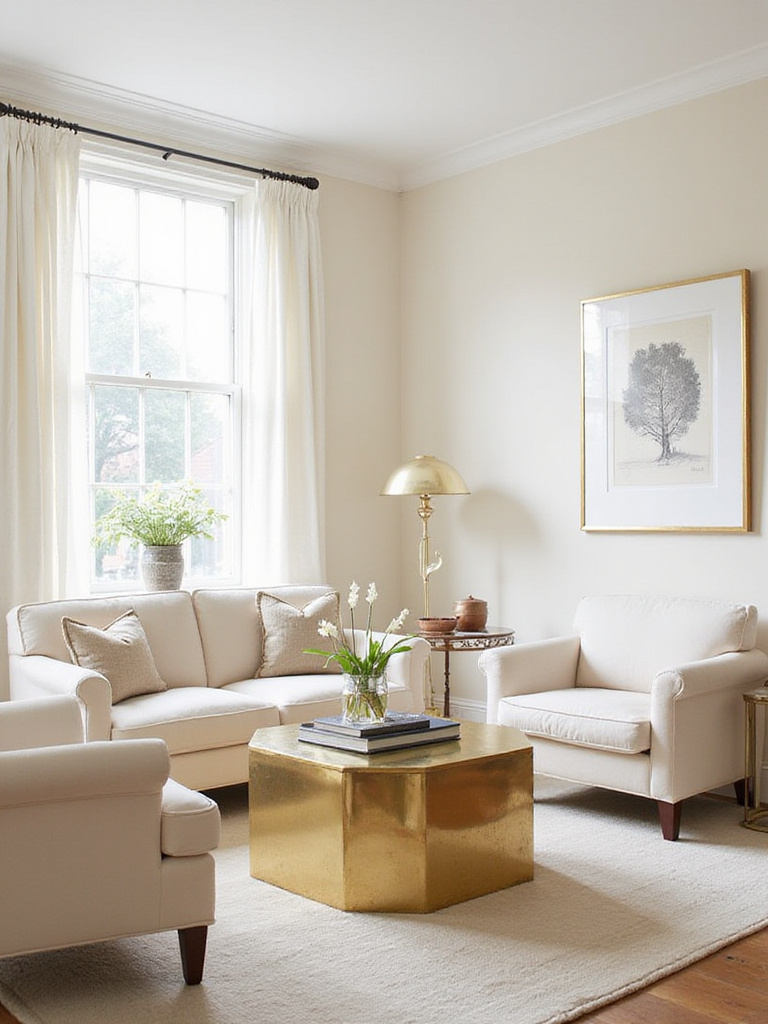
Consider floor-to-ceiling built-ins in cream or complementary neutral tones that create vertical emphasis while housing books, media equipment, and decorative objects. Open shelving with clean lines provides display opportunities while maintaining the room’s airy feel, while closed storage keeps clutter hidden and preserves the serene aesthetic. The integration of lighting within storage elements—LED strips under shelves or interior cabinet lighting—adds another layer of architectural interest while improving functionality.
The finishing touch that elevates the entire look is treating storage as an opportunity to create rhythm and proportion through repetitive elements and careful spacing.
8. Integrate Smart Technology Seamlessly
Modern cream living room design demands the seamless integration of technology that enhances rather than disrupts the sophisticated aesthetic. I specify motorized window treatments in cream or neutral tones that provide precise light control while maintaining clean lines. Hidden speakers, integrated charging stations, and concealed cable management ensure that technology serves the space without creating visual clutter that competes with the serene palette.
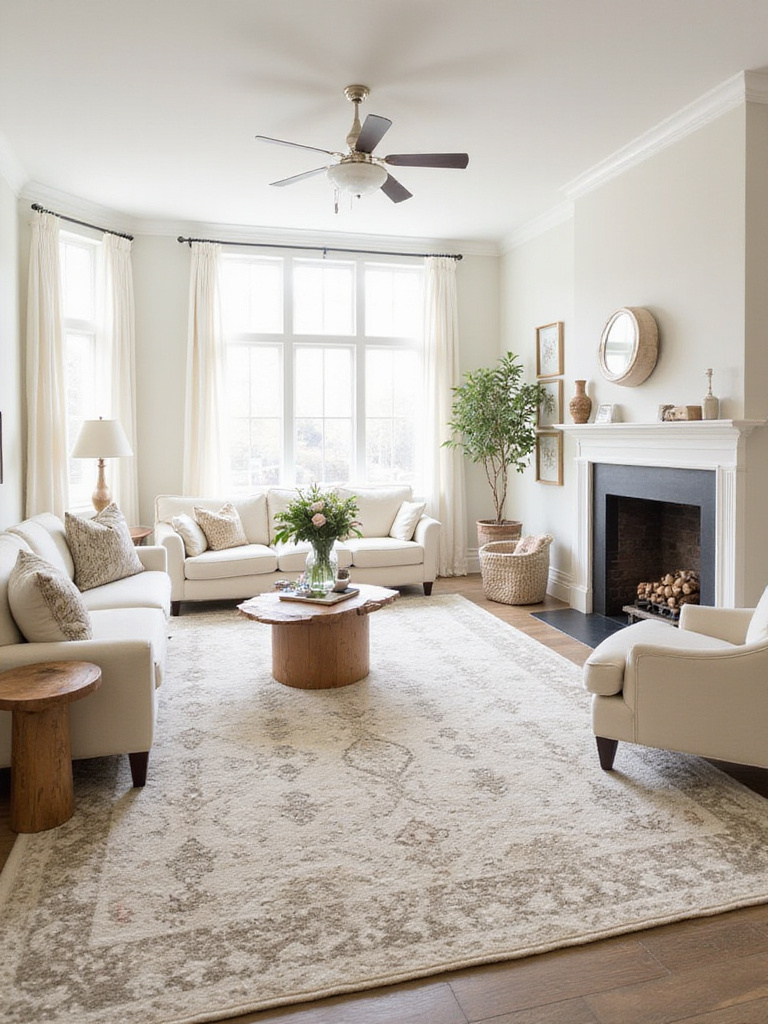
The placement of screens and entertainment equipment requires careful consideration to maintain the room’s architectural integrity. Wall-mounted displays with minimal bezels, integrated sound systems, and wireless connectivity reduce the visual impact of technology while improving functionality. Consider furniture with built-in technology features—coffee tables with wireless charging surfaces, seating with integrated USB ports, or media consoles with ventilation systems that prevent overheating while maintaining clean aesthetics.
The environmental story behind this piece began with recognizing that modern living requires technology integration that doesn’t compromise design principles.
9. Plan Flexible Furniture Arrangements
Furniture placement in cream living spaces should create dynamic arrangements that can adapt to different uses while maintaining visual flow and architectural clarity. I design around flexible seating options—modular sofas, lightweight accent chairs, and mobile ottomans—that allow for easy reconfiguration based on entertaining needs or daily use patterns. The key is selecting pieces with clean lines and appropriate scale that work both individually and as part of larger groupings.
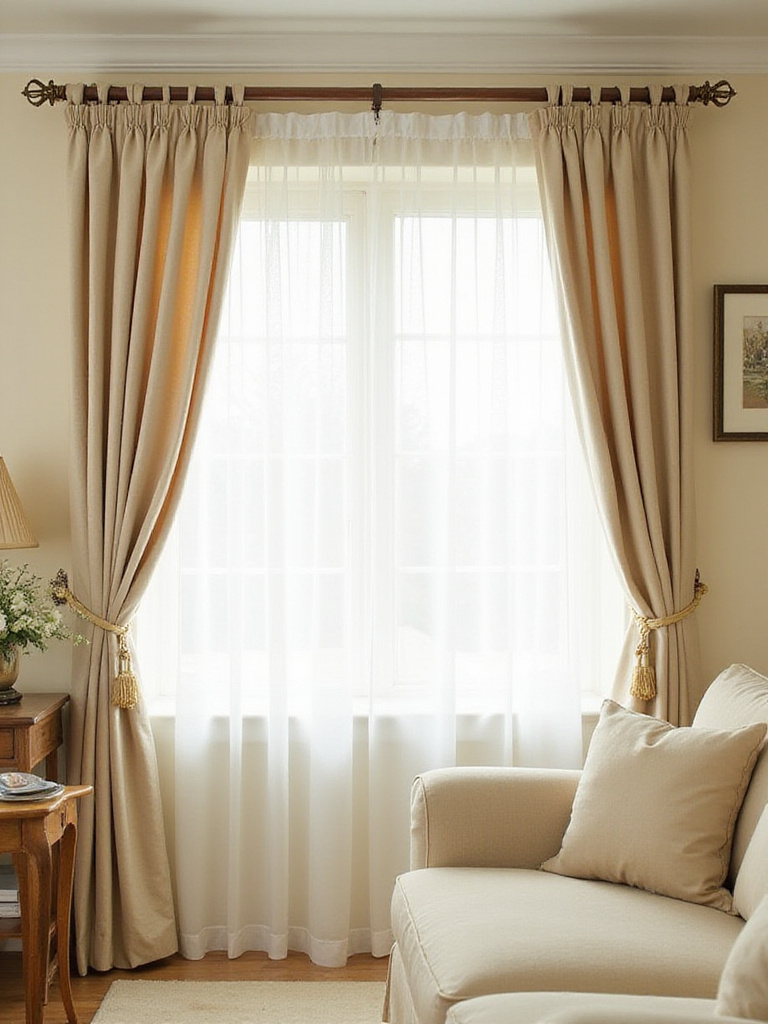
Consider the circulation patterns and sight lines when arranging furniture, ensuring that pathways remain clear while creating intimate conversation areas. Floating furniture away from walls creates a more dynamic spatial experience and allows the cream walls to serve as a backdrop rather than a boundary. The strategic use of area rugs helps define zones within larger spaces while maintaining visual continuity across the room.
Layer in dimension by simply considering how each piece relates to the others in terms of height, depth, and visual weight, creating rhythm and balance.
10. Curate Art That Commands Attention
Artwork in a cream living room should provide bold contrast and serve as the primary source of color and visual interest. I prefer large-scale pieces with strong graphic elements or rich textures that can hold their own against the neutral backdrop. The key is selecting art that enhances rather than competes with the room’s architectural elements, creating focal points that draw the eye without overwhelming the space.
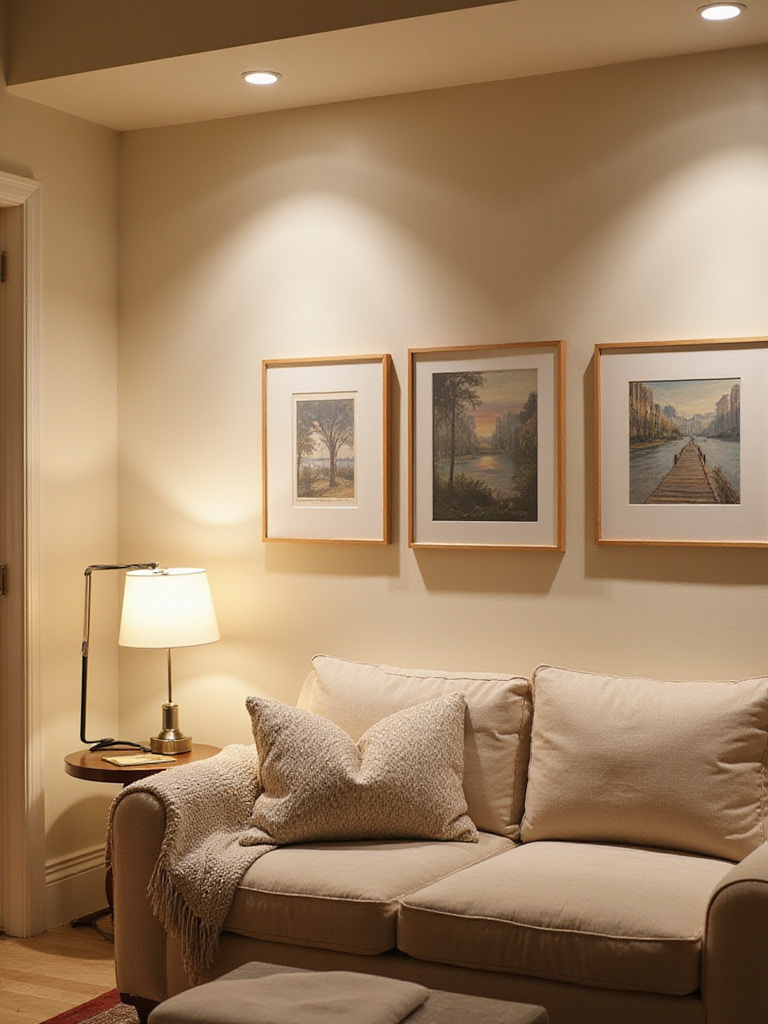
Consider the relationship between artwork and lighting, ensuring that pieces are properly illuminated to maximize their impact. Track lighting, picture lights, or strategically placed accent lighting can transform artwork from simple decoration into dramatic focal points. The scale and placement of art should relate to the room’s proportions and furniture arrangement—oversized pieces above sofas, gallery walls in hallways, or sculptural elements that interact with the room’s three-dimensional space.
The cultural heritage preserved in each piece includes the artist’s vision and the collector’s discernment, creating layers of meaning within the neutral foundation.
11. Design Custom Window Treatments
Window treatments in cream living spaces should provide precise light control while contributing to the room’s architectural character. I design custom solutions that integrate with the room’s built-in elements—motorized panels that disappear into ceiling pockets, layered systems that combine sheers with blackout options, or architectural frames that turn windows into design features. The goal is creating solutions that enhance rather than interrupt the room’s clean lines.
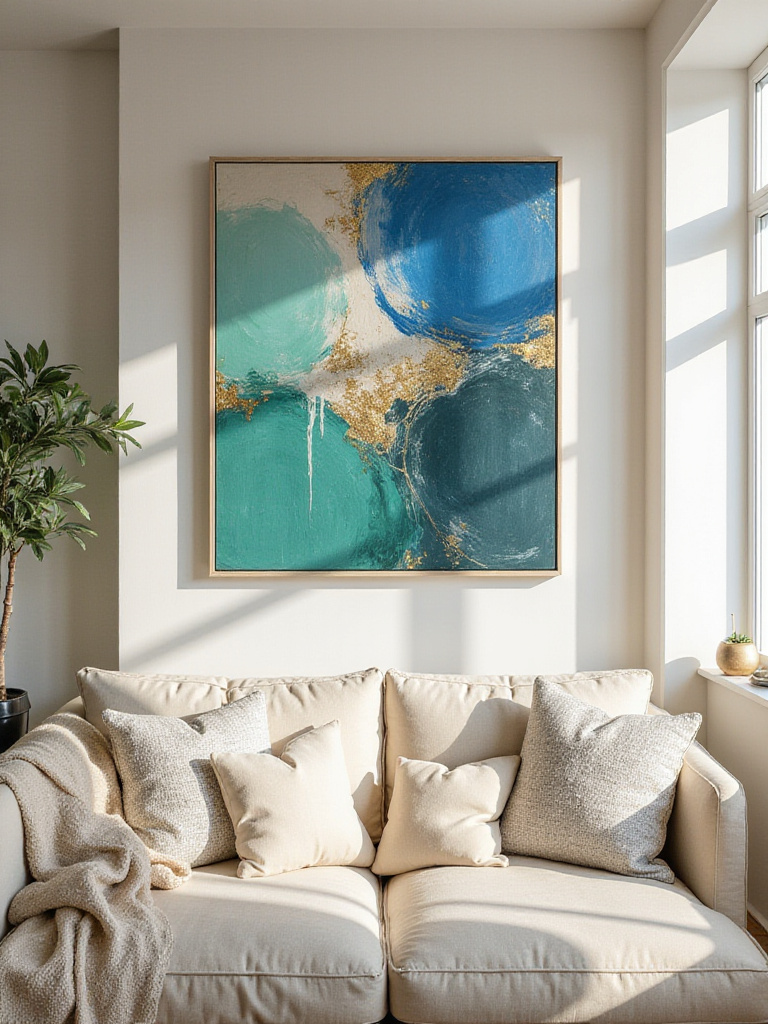
The technical aspects of window treatment design require understanding solar orientation, privacy needs, and the impact of natural light on cream surfaces throughout the day. Automated systems allow for precise control that optimizes natural light while protecting furniture and artwork from UV damage. Consider materials that complement the room’s texture palette—linen for softness, metal mesh for industrial edge, or wood slats for natural warmth.
The sustainable journey of this material involves selecting options that provide energy efficiency while maintaining the aesthetic integrity essential to sophisticated design.
12. Incorporate Living Elements Strategically
Plants and living elements in cream living room design should function as sculptural objects that add organic contrast to the architectural framework. I select specimens with strong forms—architectural succulents, dramatic fiddle leaf figs, or cascading pothos—that create visual interest while complementing the room’s clean aesthetic. The key is treating plants as design elements rather than afterthoughts, considering their scale, form, and placement as carefully as any piece of furniture.
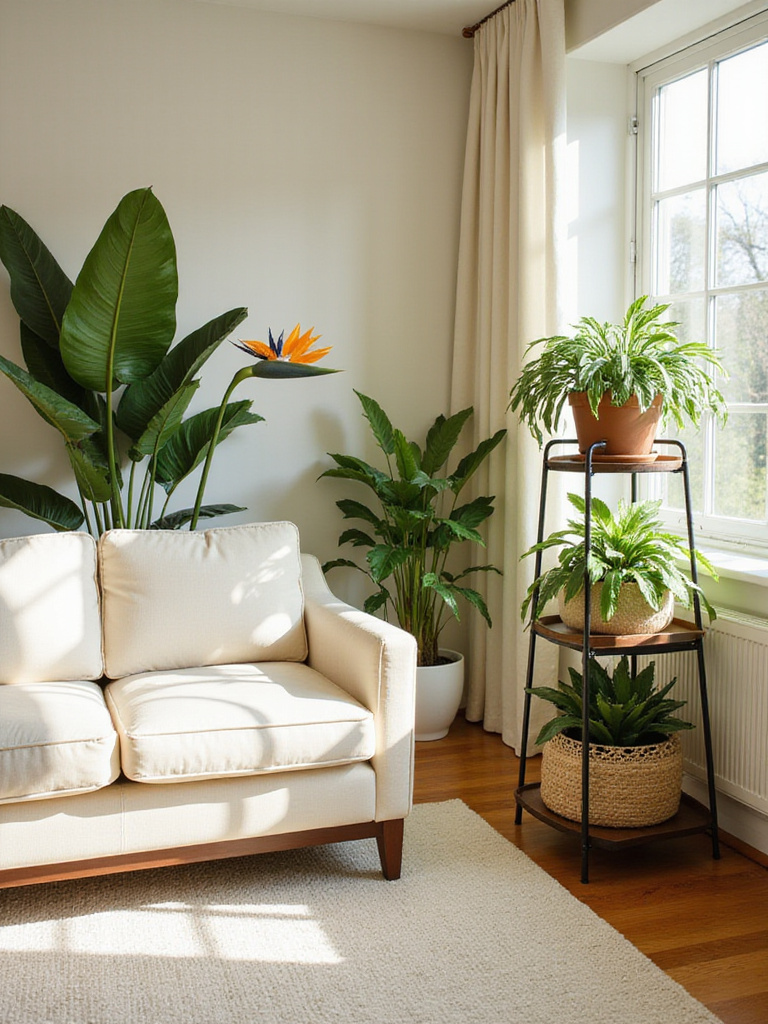
The containers and planters should integrate with the room’s material palette—concrete planters for industrial edge, ceramic vessels for refined elegance, or woven baskets for natural texture. Consider the maintenance requirements and growth patterns when selecting plants, ensuring that your choices will thrive in the available light conditions while maintaining their architectural impact over time.
The artisans’ commitment to environmental practices means selecting low-maintenance varieties that provide maximum visual impact with minimal care requirements.
13. Master Scale and Proportion
Achieving proper scale and proportion in cream living spaces requires understanding how neutral colors affect spatial perception and visual weight. I design around the principle that cream surfaces recede visually, requiring furniture and accessories with sufficient mass to create balance and prevent the space from feeling insubstantial. Oversized furniture pieces, substantial artwork, and bold architectural elements provide the visual anchors necessary to ground the design.
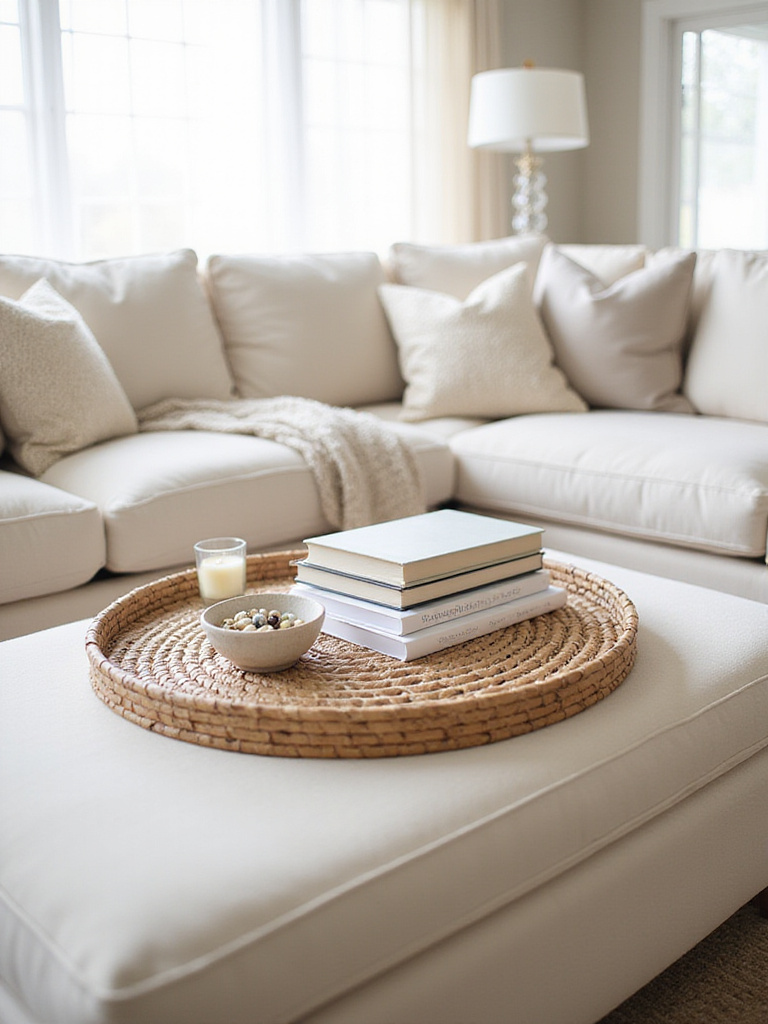
The relationship between different elements should create rhythm and hierarchy throughout the space. Large-scale furniture pieces establish the primary framework, while medium-scale accessories and smaller decorative objects fill in the details. Consider how the eye moves through the space, creating visual pathways that lead from one focal point to the next while maintaining overall balance and harmony.
The evolution of this trend reflects broader cultural shifts toward minimalism that prioritizes quality over quantity and substance over decoration.
14. Develop Sophisticated Color Accents
Color accents in a cream living room should be introduced strategically through carefully selected elements that enhance rather than compete with the neutral foundation. I prefer working with a limited palette of two to three accent colors that relate to the room’s architectural elements—perhaps drawing from the warm tones in exposed brick or the cool grays in concrete surfaces. The key is using color sparingly but with maximum impact, creating focal points that energize the space without overwhelming its serene character.
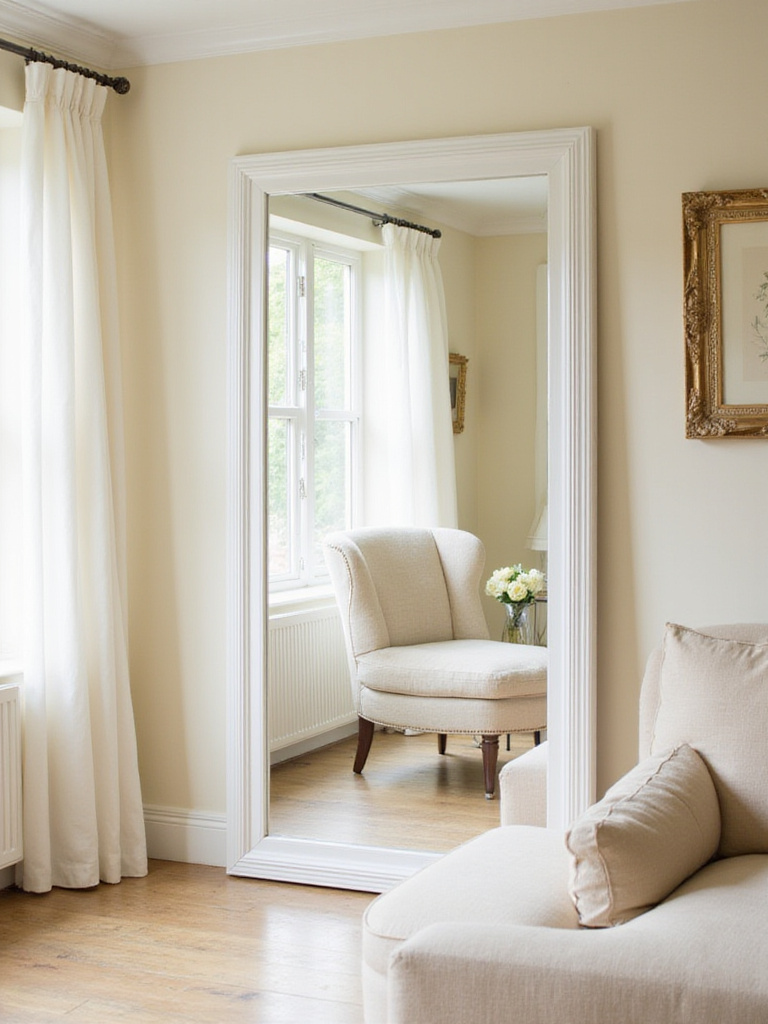
Consider the psychological impact of different colors and how they interact with cream’s calming properties. Deep blues provide sophisticated contrast, rich greens connect to natural elements, while warm metallics add luxury and refinement. The placement of color should follow the room’s architectural hierarchy—larger color elements in secondary positions, smaller accents distributed throughout to create visual flow and connection.
The forecast for next season already hints at earth tones and mineral-inspired palettes that complement cream’s natural warmth.
15. Create Dramatic Ceiling Interest
Ceiling design in cream living spaces offers opportunities to add architectural drama without competing with the wall and floor palette. I often specify exposed structural elements—steel beams, concrete slabs, or wood planking—that add texture and visual interest overhead. The key is treating the ceiling as the room’s fifth wall, using it to enhance the spatial experience while maintaining the clean aesthetic essential to sophisticated design.
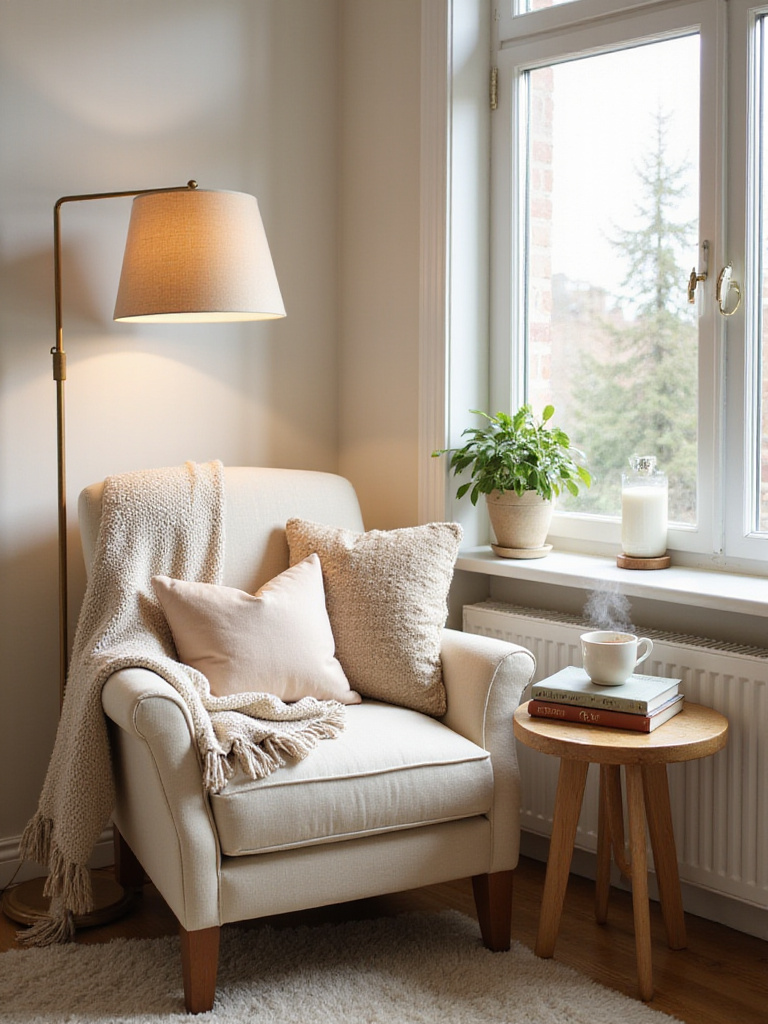
Consider lighting integration that turns the ceiling into a design feature—recessed linear systems that emphasize architectural lines, pendant clusters that create focal points, or indirect lighting that washes the ceiling with warm illumination. The height and proportions of the ceiling should influence furniture selection and room arrangement, with taller spaces accommodating larger-scale elements and lower ceilings benefiting from horizontal emphasis.
The traditional methods used result in ceiling treatments that feel integral to the architecture rather than applied decoration.
16. Design Transitional Spaces
The connections between your cream living room and adjacent spaces require careful consideration to maintain visual flow while defining distinct functional zones. I design transitional elements—changes in flooring materials, ceiling height variations, or furniture arrangements—that create subtle boundaries without interrupting the overall spatial experience. The goal is creating a sense of journey through the space while maintaining the cohesive aesthetic that makes cream palettes so effective.
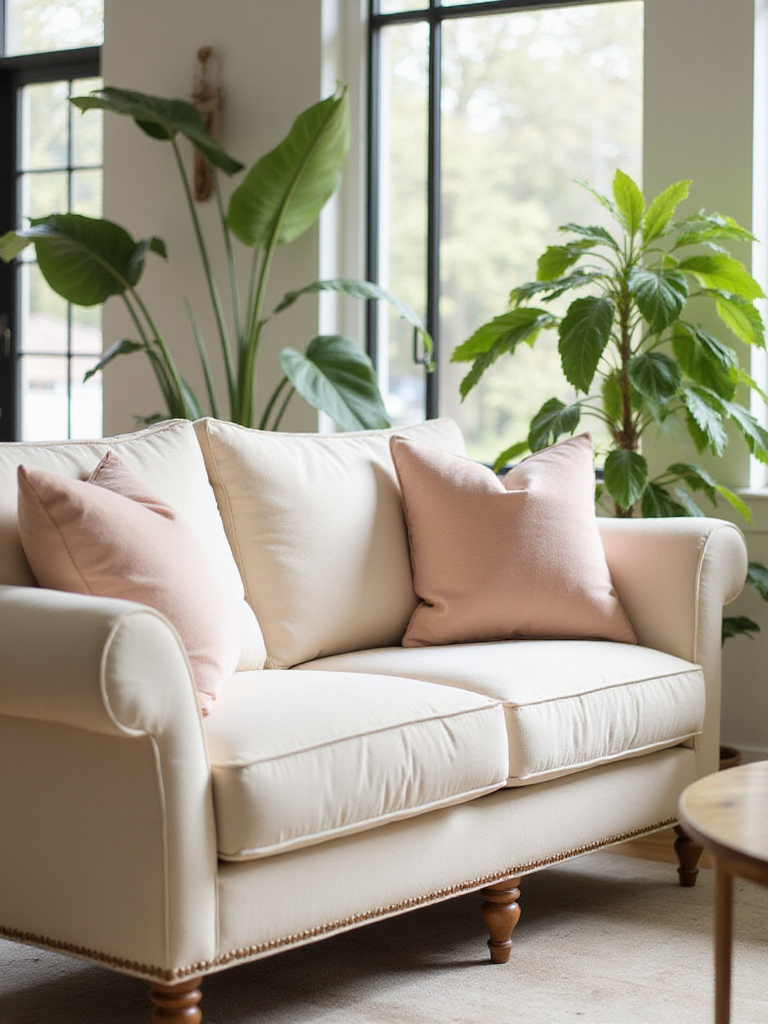
Consider how materials and finishes transition from one area to the next, using the cream foundation as a unifying element while allowing other materials to provide variation and interest. Open sight lines should be preserved where possible, while strategic placement of furniture or architectural elements can provide privacy and intimacy when needed.
The maker’s journey from apprentice to master influenced the understanding that successful space planning requires balancing openness with definition.
17. Integrate Seasonal Adaptability
Designing cream living spaces for seasonal variation requires planning for changes in natural light, temperature, and usage patterns throughout the year. I specify elements that can be easily modified—lightweight throws for warmth, adjustable lighting for shorter days, or furniture arrangements that accommodate different entertaining needs. The cream foundation provides stability while allowing for seasonal accents that keep the space feeling fresh and responsive to changing conditions.

Consider the impact of seasonal light changes on cream surfaces and how different times of year affect the room’s atmosphere. Warmer lighting during winter months, lighter fabrics for summer comfort, and flexible storage solutions for seasonal items ensure that the space remains functional and beautiful year-round.
Beyond the trends, the enduring appeal comes from creating spaces that adapt to life’s rhythms while maintaining their essential character.
18. Plan for Entertainment and Gathering
Entertainment areas within cream living room design should balance sophistication with functionality, creating spaces that encourage gathering while maintaining the refined aesthetic. I design around flexible seating arrangements that can accommodate both intimate conversations and larger groups, using modular elements that reconfigure easily while preserving the room’s visual flow. The key is planning for different scales of entertaining without compromising the space’s everyday functionality.

Consider the technical requirements for entertainment—adequate power outlets, proper ventilation for equipment, and lighting that transitions from bright task lighting to intimate ambient illumination. Built-in solutions for serving and storage keep entertaining essentials accessible while maintaining the clean lines essential to sophisticated design.
The collaboration began with a conversation about how modern living requires spaces that serve multiple functions without sacrificing aesthetic integrity.
19. Address Acoustic Considerations
Sound quality in cream living spaces requires attention to both absorption and reflection, creating environments that support conversation while controlling noise transmission. I specify materials and arrangements that provide natural acoustic treatment—upholstered furniture for absorption, hard surfaces for clarity, and spatial arrangements that prevent echo while maintaining the room’s architectural character. The goal is creating acoustically comfortable spaces that enhance rather than detract from the overall design.
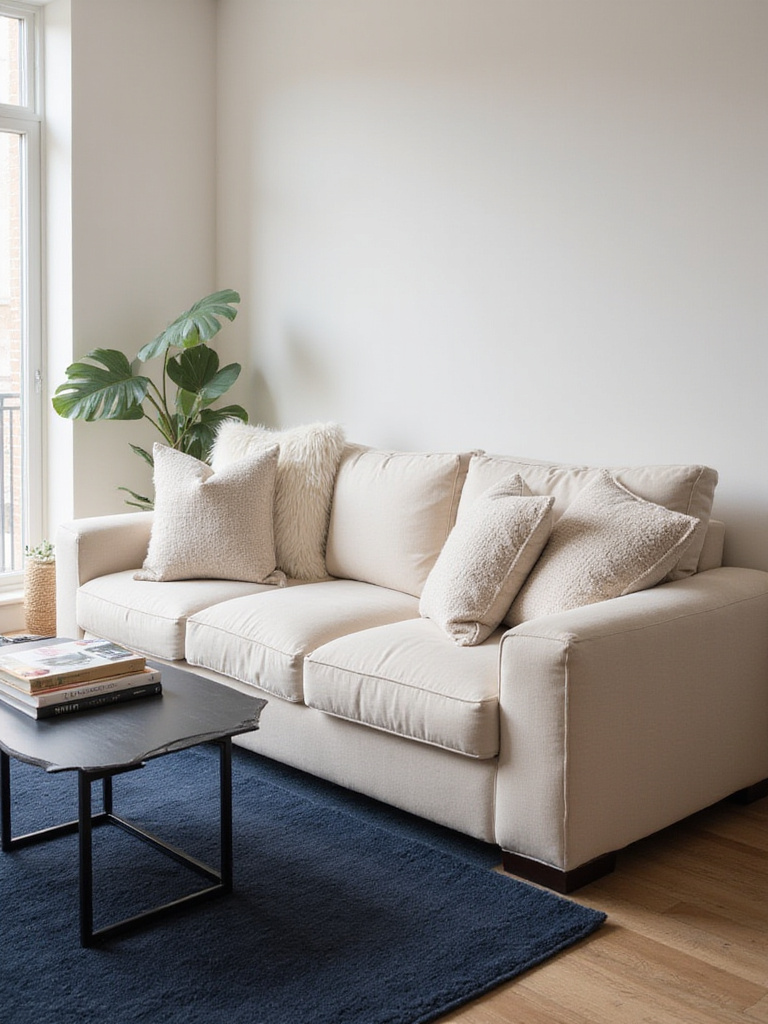
Consider how different materials affect sound quality and how furniture placement can optimize acoustic performance. Soft furnishings, area rugs, and window treatments provide absorption, while strategic placement of hard surfaces can enhance rather than compromise the listening experience.
The discovery of this technique happened when acoustic engineers began collaborating with interior designers to create spaces that sound as good as they look.
20. Develop Maintenance Strategies
Long-term maintenance of cream living room elements requires planning for both daily care and periodic refresh needs. I specify materials and finishes that age gracefully while providing detailed care instructions that preserve the space’s sophisticated appearance. The key is selecting elements that maintain their beauty with reasonable maintenance while planning for inevitable wear and updating needs.

Consider the lifecycle costs and replacement schedules for different elements, from high-wear upholstery to architectural finishes that may require periodic renewal. Documentation of specifications, care requirements, and source information ensures that maintenance and updates preserve the design’s integrity over time.
The investment value comes from the exceptional planning that ensures your cream living space remains beautiful and functional for years to come.
21. Integrate Personal Collections
Personal collections within cream living spaces should be displayed as curated exhibitions that enhance rather than clutter the sophisticated aesthetic. I design display systems—built-in shelving, gallery lighting, or custom cases—that showcase meaningful objects while maintaining the room’s architectural clarity. The key is treating collections as integral design elements rather than afterthoughts, giving them the prominence they deserve while preserving the space’s serene character.

Consider the relationship between collection pieces and the room’s scale, ensuring that displays create visual interest without overwhelming the neutral foundation. Lighting, spacing, and background treatments should enhance the collection’s impact while maintaining the overall design’s sophistication.
The third-generation workshop where this comes to life demonstrates how personal meaning and sophisticated design can coexist beautifully.
22. Plan Technology Infrastructure
Future-proofing your cream living room requires planning technology infrastructure that can adapt to changing needs while maintaining the space’s clean aesthetic. I specify robust electrical systems, high-speed networking, and flexible mounting solutions that accommodate current needs while allowing for future upgrades. The goal is creating spaces that remain technologically relevant without requiring major renovations.
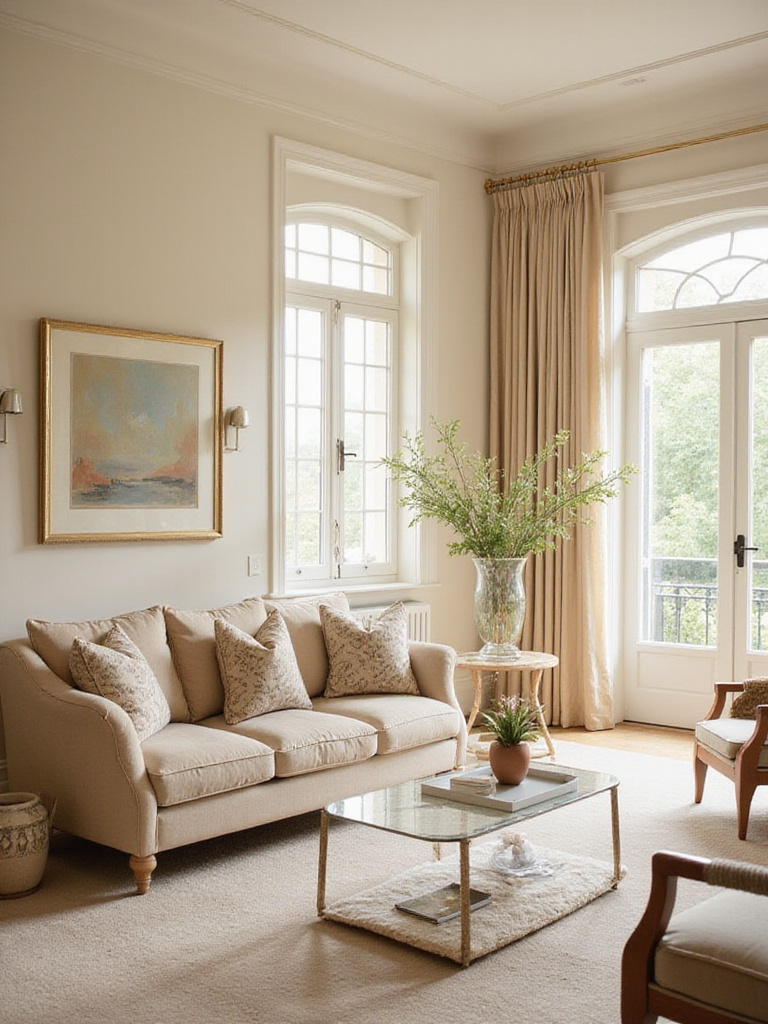
Consider the placement of outlets, data connections, and equipment storage that serves current needs while anticipating future requirements. Wireless systems reduce visible infrastructure while providing the connectivity modern living demands.
The heritage technique gets a contemporary update through integration methods that hide complexity while maintaining accessibility and functionality.
23. Create Outdoor Connections
The relationship between your cream living room and outdoor spaces should create seamless transitions that extend the living area while maintaining distinct character. I design openings, sight lines, and material transitions that connect interior and exterior spaces while preserving the sophisticated aesthetic that makes cream interiors so appealing. The key is creating flow without compromising the controlled environment that allows cream palettes to thrive.
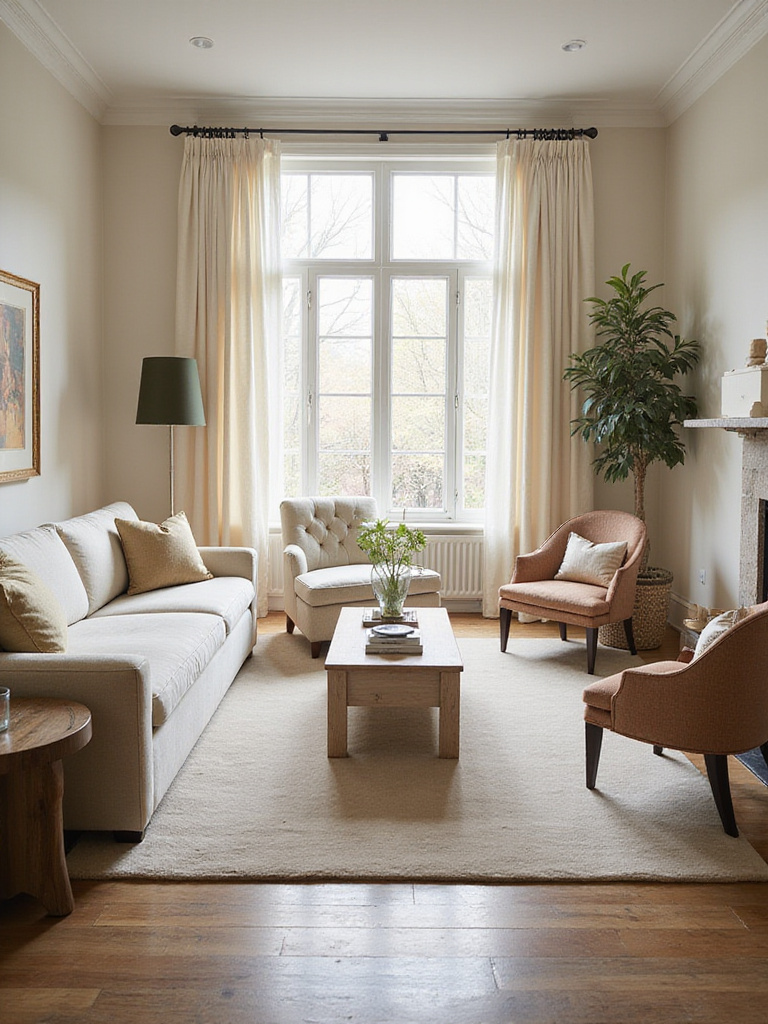
Consider how outdoor views, natural light, and seasonal changes affect the interior space, designing elements that enhance these connections while maintaining the room’s architectural integrity. Materials, colors, and furniture arrangements should acknowledge the outdoor relationship while preserving the interior’s refined character.
The materials are sourced from a remarkable region where interior and exterior boundaries blur, creating spaces that feel connected to their environment while maintaining their sophisticated identity.
Conclusion
Creating an exceptional cream living room requires more than selecting neutral colors—it demands the strategic integration of architectural elements, sophisticated materials, and thoughtful planning that prevents the space from feeling bland or sterile. Through these 23 strategies, we’ve explored how industrial accents, natural materials, and carefully considered proportions transform cream palettes into dynamic, livable environments that balance serenity with visual interest.
The key to success lies in treating cream as a foundation rather than a limitation, using its neutral properties to showcase bold architectural elements, rich textures, and sophisticated material combinations. Whether incorporating concrete accents for urban edge, layering metals for visual complexity, or planning flexible arrangements for modern living, each element should contribute to a cohesive vision that feels both timeless and contemporary.
Your cream living room should reflect your lifestyle while maintaining the sophisticated aesthetic that makes neutral palettes so enduringly appealing. Start with the foundational elements—performance fabrics, architectural lighting, and proper scale—then layer in the personal touches that make the space uniquely yours. The result will be a room that serves as both a serene retreat and a sophisticated backdrop for modern living.
